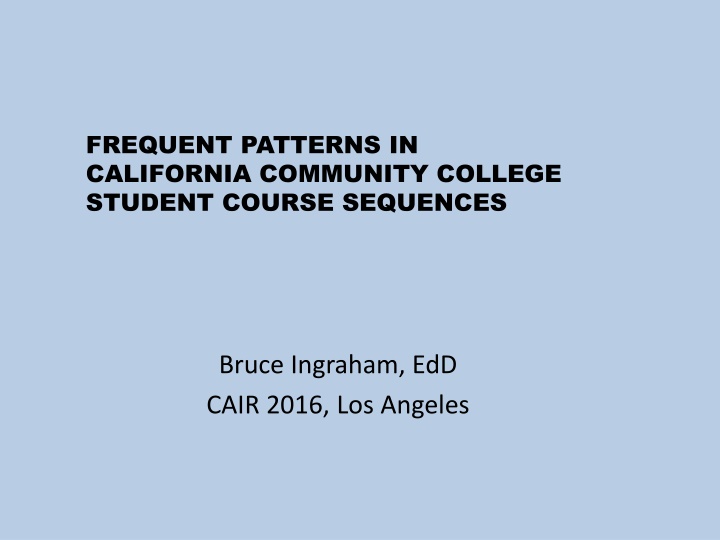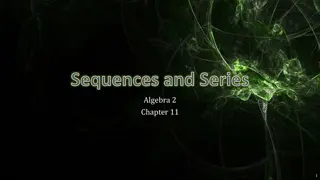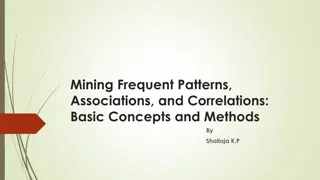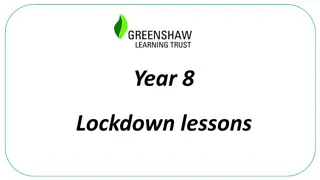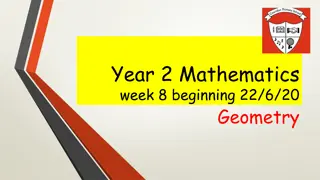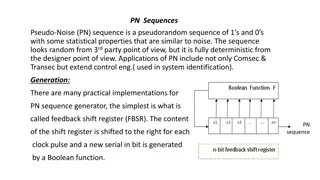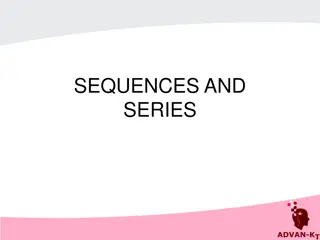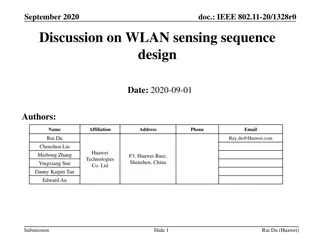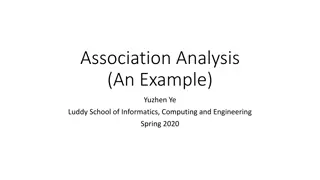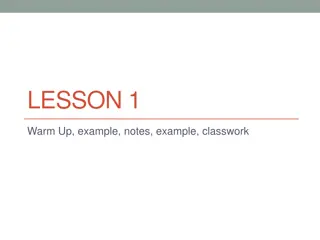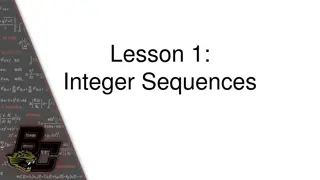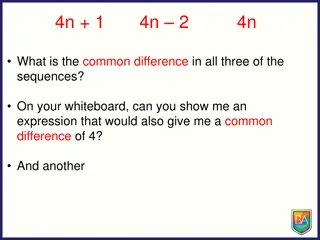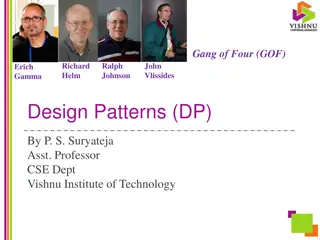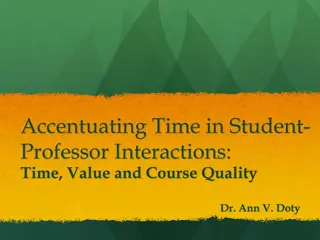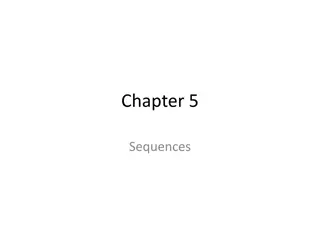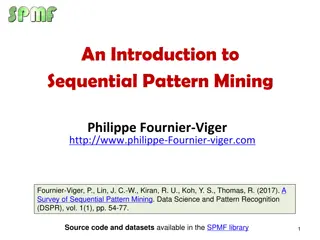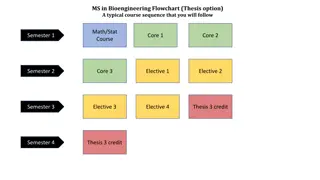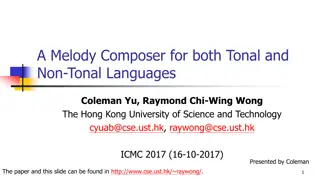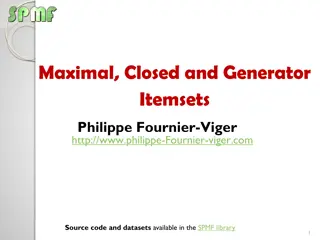Frequent Patterns in California Community College Student Course Sequences
This study explores the various student typologies, educational goals, demographics, and behaviors within California Community Colleges. Through detailed analysis of student diversity, college preparedness, and lingering at community colleges, this research sheds light on the patterns and trends observed in student course sequences. The findings provide valuable insights into the community college student population, their academic journeys, and the factors influencing their educational experiences.
Download Presentation

Please find below an Image/Link to download the presentation.
The content on the website is provided AS IS for your information and personal use only. It may not be sold, licensed, or shared on other websites without obtaining consent from the author.If you encounter any issues during the download, it is possible that the publisher has removed the file from their server.
You are allowed to download the files provided on this website for personal or commercial use, subject to the condition that they are used lawfully. All files are the property of their respective owners.
The content on the website is provided AS IS for your information and personal use only. It may not be sold, licensed, or shared on other websites without obtaining consent from the author.
E N D
Presentation Transcript
FREQUENT PATTERNS IN CALIFORNIA COMMUNITY COLLEGE STUDENT COURSE SEQUENCES Bruce Ingraham, EdD CAIR 2016, Los Angeles
Frequent Patterns in CCC Student Course Sequences Outline Introduction Student Typologies Lingering at community college Assumptions Methods Results Discussion Summary 2
Frequent Patterns in CCC Student Course Sequences Introduction Multiple missions (California Community Colleges System Strategic Plan, 2006) Associate degrees and certificates Transfer education Basic skills and English language proficiency Economic and workforce development Lifelong learning 3
Frequent Patterns in CCC Student Course Sequences Student diversity Educational goals Demographics College preparedness How they use the colleges 4
Frequent Patterns in CCC Student Course Sequences Student Typologies (Boughan, 2000). The role of academic process in student achievement: An application of structural equation modeling and cluster analysis to community college longitudinal data. (Adelman, 2005). Moving into town and moving on: The community college in the lives of traditional age students. (Hagedorn & Prather, 2005). The community college solar system: If university students are from Venus community college students must be from Mars. (Ammon, Bowman, & Mourad, 2008). Who are our students? Cluster analysis as a tool for understanding community college student populations. (Horn & Weko, 2009). On track to complete? A taxonomy of beginning community college students and their outcomes 3 years after enrolling: 2003 04 through 2006. (Bahr, 2010). The bird's eye view of community colleges: A behavioral typology of first time students based on cluster analytic classification. (Bahr, 2011). A typology of students' use of the community college. 5
Frequent Patterns in CCC Student Course Sequences Lingering at community college Adelman community college residence trichotomy, town metaphor Homeowners (37%) at least 30 units at least 60% of total undergraduate units Tenants (18%) at least 30 units fewer than 60% of undergraduate units Visitors (45%) 1 to 30 units Hagedorn and Prather solar system metaphor While about half of the students have been enrolled for more than 4 years, approximately 15% have been enrolled for over 10 years within an educational environment that is frequently called a two-year college (p. 11). 6
Frequent Patterns in CCC Student Course Sequences Bahr (2011) Table 3.1 (p. 39) 7
Frequent Patterns in CCC Student Course Sequences Assumptions Departments offer courses in sequences e.g. calculus 1, calculus 2, calculus 3, linear algebra, differential equations Transfer-oriented students enroll in sequences of courses relevant to their intended baccalaureate majors Students with similar interests form informal cohorts who enroll in the same or similar sequences of courses Therefore, it should be possible to discover groups of students with similar sequences of courses over time 8
Frequent Patterns in CCC Student Course Sequences Data Source Patrick Perry, former Vice Chancellor of Technology, Research, and Information Systems, CCCCO Peter Bahr, University of Michigan, School of Education, Center for the Study of Higher and Postsecondary Education Each campus had unique course IDs Each campus had to be analyzed separately Could not capture swirling Students who attempted more than 60 units Three largest campuses East Los Angeles Mt. San Antonio Santa Ana 10
Frequent Patterns in CCC Student Course Sequences Analysis method Sequential Pattern Mining (SPM) Data mining The exploration and analysis, by automatic or semiautomatic means, of large quantities of data in order to discover meaningful patterns and rules (Berry & Linhoff, 1997, p. 5) The analysis of (often large) observational data sets to find unsuspected relationships and to summarize the data in novel ways that are both understandable and useful to the data owner (Hand, Mannila, & Smyth, 2001, p. 1) Data mining is NOT statistics 11
Frequent Patterns in CCC Student Course Sequences SPM introduced by Agrawal & Srikant (1995) Discovers frequent patterns in a sequence database Courses in a frequent pattern do not have to be in consecutive terms Frequent patterns can have two or more courses in a term Support and minimum support Anti-monotonicity (Ng, Lakshmanan, Han, & Pang, 1998) all subsequences of frequent patterns are frequent longer frequent patterns cannot have greater support than shorter subsequences Maximal frequent patterns (MFP) R arulesSequences package (Buchta & Hahsler, 2012; Hahsler, Buchta, Gr n, & Hornik, 2010; Hahsler, Chelluboina, Hornnik, & Buchta, 2011; Hahsler, Gr n, & Hornik, 2005) 12
Frequent Patterns in CCC Student Course Sequences Results 13
Frequent Patterns in CCC Student Course Sequences Exploratory data analysis Sequence lengths: attempted units frequency distribution Number of items: course frequency distribution 14
Frequent Patterns in CCC Student Course Sequences Sequential Pattern Mining Maximal frequent patterns East Los Angeles: 602 Mt. San Antonio: 323 Santa Ana: 415 Longest MFPs 17
Frequent Patterns in CCC Student Course Sequences East Los Angeles 18
Frequent Patterns in CCC Student Course Sequences East Los Angeles 19
Frequent Patterns in CCC Student Course Sequences Mt. San Antonio 20
Frequent Patterns in CCC Student Course Sequences Santa Ana 21
Frequent Patterns in CCC Student Course Sequences Santa Ana 22
Frequent Patterns in CCC Student Course Sequences Santa Ana 23
Frequent Patterns in CCC Student Course Sequences Discussion 24
Frequent Patterns in CCC Student Course Sequences Results were unexpected What we have found, in all the labs that we have studied, is that over half of the findings that scientists obtain are unexpected. Thus, one important problem that scientists must cope with is both interpreting the unexpected findings and deciding what to do next. Scientists initial reaction to an unexpected finding is that the finding is due to some sort of methodological error (Dunbar, 2001, p. 317). 25
Frequent Patterns in CCC Student Course Sequences Verification of assumptions (Slide 7) Departments do offer courses in sequences. Transfer-oriented students did not enroll in sequences of courses that are transferable to a major subject in a baccalaureate program. Instead, they seemed to enroll in introductory courses in many different subjects. Students with similar interests did not form informal cohorts. Instead, they seemed to go their separate ways. 26
Frequent Patterns in CCC Student Course Sequences Frequent courses in MFPs Basic skills math (pre-algebra, elementary algebra, and intermediate algebra) Basic skills English (two-course sequence of pre-transfer reading and composition) public speaking freshman English critical thinking US history US government introduction to psychology introduction to sociology introduction to statistics 27
Frequent Patterns in CCC Student Course Sequences Basic skills Repeated basic skills math courses Gaps in basic skills sequences Enrolled in basic skills math and English sequentially rather that concurrently Which subject, math or English, came first varied by campus 28
Frequent Patterns in CCC Student Course Sequences Related Literature 29
Frequent Patterns in CCC Student Course Sequences Dispersal of first-time students is one of the distinguishing, but often unnoted, characteristics of the community college and possibly one of several reasons why there is so little community among the students. There is no broad common first year, or even first semester, experience for the new students. Though the colleges are not perceived as unfriendly, there are relatively few social bonds between the students, few participate together in campus organizations, and little leisure time is spent with each other on campus (Maxwell et al., 2003, p. 39). 30
Frequent Patterns in CCC Student Course Sequences One of the more revealing findings was that just over 50% of all courses taken by our sample were remedial, indicating that they are spending half of their time taking non-transferable college- level courses. In other words, the transfer students in this sample averaged enrolling in courses over a five-year time span but transferred only the equivalent of one year s worth of full time study credits (Melguizo, Hagedorn, & Cypers, 2008, p. 417). 31
Frequent Patterns in CCC Student Course Sequences Many younger students entering community colleges from high schools are experimenters, unsure about the relationship between schooling and their aspirations. Such students come to community colleges because they are low-cost and convenient places for generating more information about their career and educational options. These students, however, usually develop information by taking courses almost at random, and this is not necessarily an effective route (Grubb, 2006, p. 197). 32
Frequent Patterns in CCC Student Course Sequences At a community college, any given student is relatively unlikely to be following exactly the same path as another and even students who do follow the same path may be unlikely to know it (Scott-Clayton, 2011, p. 14). 33
Frequent Patterns in CCC Student Course Sequences Summary 34
Frequent Patterns in CCC Student Course Sequences The sequence in which courses were taken was important for pre-transfer courses in math and English. The course sequence was not important for transfer courses because students rarely took more than one or two courses in the same subject. One reason that transfer-oriented students lingered at community college was difficulty completing the pre- transfer courses in math and English. Students enrolled in a great variety of courses, many of which had three or fewer students from the sample. 35
Frequent Patterns in CCC Student Course Sequences Acknowledgements I thank Patrick Perry and the Chancellor s Office of the California Community Colleges for granting permission to use the data employed in this study and authorizing Peter Bahr to provide these data. I am also greatly indebted to Peter Bahr at the University of Michigan for providing data from his previous research. 36
Frequent Patterns in CCC Student Course Sequences References 37
Frequent Patterns in CCC Student Course Sequences Adelman, C. (2005). Moving into town and moving on: The community college in the lives of traditional age students. Retrieved from Washington, DC: Agrawal, R., & Srikant, R. (1995). Mining sequential patterns. Proceedings of the 1995 International Conference on Data Engineering (pp. 3-14). Taipei, Taiwan. Ammon, B. V., Bowman, J., & Mourad, R. (2008). Who are our students? Cluster analysis as a tool for understanding community college student populations Journal of Applied Research in the Community College, 16(1), 32-44. Bahr, P. R. (2010). The bird's eye view of community colleges: A behavioral typology of first-time students based on cluster analytic classification. Research in Higher Education, 51, 724-740. Bahr, P. R. (2011). A typology of students' use of the community college. New Directions for Institutional Research, Assessment Supplement, 33-48. Berry, M. J. A., & Linhoff, G. (1997). Data mining techniques: For marketing, sales, and customer support. New York: Wiley. Boughan, K. (2000). The role of academic process in student achievement: An application of structural equation modeling and cluster analysis to community college longitudinal data. AIR Professional File, 74, 1-17. Buchta, C., & Hahsler, M. (2012). arulesSequences: Mining frequent sequences (Version 0.2-4)[Computer software]. Retrieved from http://cran.cnr.berkeley.edu California Community Colleges System Strategic Plan Steering Committee. (2006). California Community Colleges system strategic plan. Sacramento: California Community Colleges Board of Governors. Dunbar, K. (2001). The analogical paradox: Why analogy is so easy in naturalistic settings, yet so difficult in the psychological laboratory. In D. Gentner, K. J. Holyoak, & B. N. Kokinov (Eds.), The analogical mind: Perspectives from cognitive science. Cambridge, MA: MIT Press. Grubb, W. N. (2006). "Like, what do I do now?": The dilemmas of guidance counseling. In T. Bailey & V. S. Morest (Eds.), Defending the community college equity agenda. Baltimore: Johns Hopkins University Press. 38
Frequent Patterns in CCC Student Course Sequences Hagedorn, L. S., & Prather, G. (2005). The community college solar system: If university students are from Venus community college students must be from Mars. Paper presented at the Annual Forum of the Association of Institutional Research, San Diego, CA. Hahsler, M., Buchta, C., Gr n, B., & Hornik, K. (2010). arules: Mining association rules and frequent itemsets (Version 1.0-14)[Computer software]. Retrieved from http://cran.cnr.berkeley.edu Hahsler, M., Chelluboina, S., Hornnik, K., & Buchta, C. (2011). The arules R-package ecosystem: Analyzing interesting patterns from large transaction databases. Journal of Machine Learning Research, 12, 2012-2025. Hahsler, M., Gr n, B., & Hornik, K. (2005). arules A computational environment for mining association rules and frequent itemsets. Journal of Statistical Software, 14(12), 1-25. Hand, D., Mannila, H., & Smyth, P. (2001). Principles of data mining. Cambridge, MA: MIT Press. Horn, L., & Weko, T. (2009). On track to complete? A taxonomy of beginning community college students and their outcomes 3 years after enrolling: 2003 04 through 2006 (NCES 2009-152). Retrieved from Washington, DC: Maxwell, W., Hagedorn, L. S., Cypers, S., Moon, H. S., Brocato, P., Wahl, K., & Prather, G. (2003). Community and diversity in urban community colleges: Coursetaking among entering students. Community College Review, 30(4), 21-46. Melguizo, T., Hagedorn, L. S., & Cypers, S. (2008). Remedial/developmental education and the cost of transfer: A Los Angeles county sample The Review of Higher Education, 31(4), 401-431. Ng, R. T., Lakshmanan, L. V. S., Han, J., & Pang, A. (1998). Exploratory mining and pruning optimizations of constrained associations rules. Paper presented at the 1998 ACM SIGMOD international conference on Management of data, Seattle, Washington, USA. Scott-Clayton, J. (2011). The shapeless river: Does a lack of structure inhibit students' progress at community colleges? (CCRC Working Paper No. 25). New York: Columbia University, Teachers College, Community College Research Center. 39
Frequent Patterns in CCC Student Course Sequences Questions? 40
Frequent Patterns in CCC Student Course Sequences Contact information ingraham@cal.berkeley.edu 415-377-4068 41
